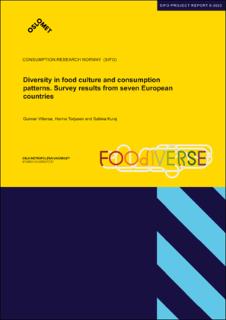| dc.description.abstract | In this report we have mapped diversity in food consumption in Europe with a view to organic, sustainable and local food, based on a survey with more than 15 000 respondents from Germany, Italy, Norway, Poland, the UK, France and Spain. The aim was to have a closer look on the state of dietary diversity as well as consumers’ perceptions and practices in relation to sustainability of food.
The analysis shows that it is a European divide in eating patterns as well as perceptions and consumption practices. Higher eating frequencies for vegetables, fruits and fish were found in the Mediterranean countries and relatively lower frequencies of meat, compared to northern Europe. Respondents in southern countries to a greater extent emphasized the origin of food, knowing the producer and that food is local and in season. Polish and Italian respondents used local markets and direct purchases from the producer more than in the other European countries.
The results show a socio-demographic divide related to gender and age. Vegetables and fruits were consumed more often by women than men and in the elder - more than in the younger age groups. The highest age group more frequent answered “not relevant” to some of the supply channels (e.g. online purchase of food), which may indicate that some types of supply channels are less available for elder people. Higher education levels associate with frequent vegetable and fruit consumption. Consumption of local and organic food is often associated with high socio-economic status. We found that this to some extent is true for organic food, but it varies between countries and the income divide is most prominent in the UK and Germany.
A deeper understanding of the factors that influences dietary and sustainable food practices as well as how and why these practices vary on national and regional scales, needs further analyses supplemented with qualitative methods that will be conducted at later stages within the FOOdIVERSE project. | en_US |
